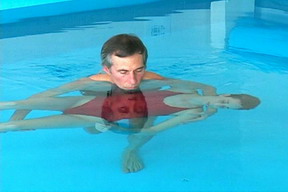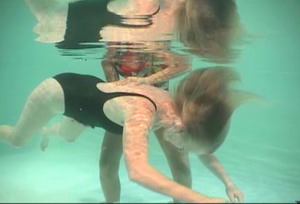Aquatic Bodywork & Therapy

Aquatic bodywork improves the body’s general health by reducing tension, calming the nervous system and stimulating the circulatory and immune systems. Water takes the weight off the vertebrae and relaxes the muscles. Less tension in the spine and the musculature removes excess pressure on nerves and improves the tone and functioning of the whole body and the organs those nerves service. Water moulds itself to respond to individual needs and its support and resistance protects against injury. Uniform pressure on all parts of the body allows for unrestricted circulation to carry away metabolites left over in the muscles.
Aquatic bodywork affects multiple levels – physical, emotional, psychological – and gradually heals and corrects imbalances, leading to improved body/mind awareness and a general sense of well-being and peace. Its psychosomatic effects have been used worldwide to treat cancer, heart disease, aids, chronic pain, psychological traumas, bone and muscle strains and injuries, insomnia, and addictions.
A session can reduce blood pressure, diminish muscular tension, increase flexibility and range of motion, extend the vertebral column, improve posture, circulation, breathing and sleeping patterns, reduce depression and stress, calm the nervous system, address addictions, emotional and psychological traumas, alleviate spinal and muscular tensions during pregnancy, and reduce acute and chronic pain.
Aquatic Bodywork and Pain

People with chronic pain conditions including arthritis, fibromyalgia, rheumatism, back injuries, osteoporosis, and multiple sclerosis have seen extraordinary results with aquatic bodywork. A study was conducted at the Queen Elizabeth Hospital in Rotorua on 13 women with Fibromyalgia Syndrome. They all showed significant improvement using the SF-36 General Health Survey. There were large differences in physical functioning, bodily pain, vitality, and social functioning and the study concluded that aquatic bodywork provided an effective holistic intervention for this sample. Further research is required, however, to understand the dynamics of aquatic bodywork and the extent to which its results are generalisable.
Physical pain is a complex phenomenon that initiates a vicious circle:
Irrespective of the cause, people in pain will often avoid physical activity to prevent increasing their pain. This is because the body’s natural response to a trauma is to contract muscles and tighten joints in an effort to guard the affected area from further damage. After the acute phase of pain is passed, muscular holding patters can become habitual and limit the return of flexibility. Patients with back pain often become sedentary and subsequently lose strength in their ventral and dorsal muscles. These muscles help stabilize the spine, and their condition worsens, causing distortion in motion or posture. Immobility leads to limited range of motion, muscle tightness, weakness, and emotional stress. Muscles often begin to go into spasm and, in the long term, patients experience more pain. The person in pain may resort to a variety of drugs, analgesics, or surgery. Stored biochemicals from these methods result in more areas of inactivity and ultimately, more pain. And the cycle goes on.
How does aquatic bodywork affect the cycle? 
To begin with, warm water reduces pain sensitivity: the warmth “distracts” the pain, because sensory nerve fibers that detect warmth are larger, faster, and have greater conductivity than pain fibers. (Pain signals travel at 1m per second, warmth signals at 50m per second, and touch signals at 100m per second).
Since the pain is less, muscle guarding drops, and the person is more receptive to manipulation and stretching. Muscles relax, reducing both physical and emotional tension and the client can be shown a new way of being in their body and dealing with its limitations. In water, the body is free from gravity, weight is taken off the joints and they are free to move in a physiological way. The body is given the chance to get rid of its old posture and movement patterns, which are often responsible for maintaining pain-related illnesses. Unrestricted by contraction, the circulation can carry away metabolites left over in the muscles and thereby reduce soreness and fatigue. In addition, weightlessness reduces pressure on the nerves and therefore improves the tone and functioning of the whole body and the organs those nerves service.
Over time, muscles become longer and more supple, joints become looser and more limber, the nervous system becomes calmer, and the entire body is stimulated to function in a more healthy state of equilibrium, homeostasis, or holistic balance. This in turn allows us to move through our lives with greater emotional flexibility. Experiencing greater flexibility and freedom reprograms the client to face life out of the water with greater equanimity.
The aim of aquatic bodywork is to ultimately improve the quality of life of clients. Water sessions give them this opportunity and allow the body new possibilities of freedom. They can then to flow into a level of being where there is joy and peace and wholeness, where their condition or trauma can no longer overwhelm them.
Contraindications to Aquatic Bodywork
Absolute contraindications – not appropriate for aquatic therapy
- Fever over 100 degrees
- Uncontrolled epilepsy
- Cardiac failure
- Significant open wounds
- Respiratory disease of vital capacity less than 1500 cm2
- Sever urinary tract infection
- Blood infection
- Tracheostomy
- Bowel incontinence
- Menstruation without internal protection
- Infectious disease
Relative contraindications – may not be appropriate/ necessary precaution may need to be taken
- Skin infections with drainage
- Small open wounds (can be covered)
- Low blood pressure
- Unstable angina, cardiac arrythmias or additional cardiac considerations
- Intravenous lines, heplocks, hichman line, external collection devices
- Cerebral hemorrhage (should wait at least 3 weeks after bleeding has ceased)
- Multiple sclerosis – may not tolerate warm water well
- Sensitivity to chlorine or other chemicals
- Absence of cough reflex
- Dizziness
- Behavioural problems
- Frequent ear infections
Range of motion precautions
- Recent total hip replacement
- Recent surgery
- Acute ligament instability
- Recent bone fracture
- Arthritic cervical spine
- Fibromyalgia
- Bulged/herniated disc
- Spondylolethesis
- Arthritis